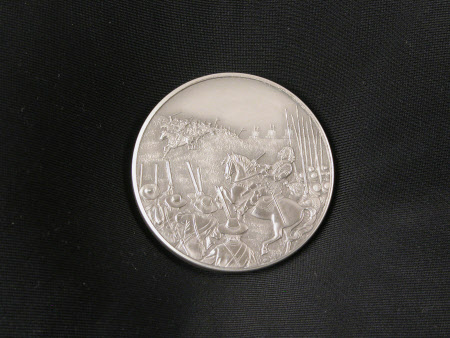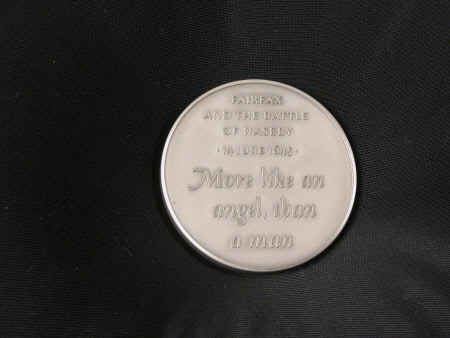Fairfax and the Battle of Naseby
Michael Rizzello (1926-2004)
Category
Coins and medals
Date
1992 - 1993
Materials
Silver
Measurements
517 mm (Diameter)
Place of origin
United Kingdom
Order this imageCollection
Osterley Park and House, London
NT 773254
Summary
Silver, Fairfax and the Battle of Naseby, medal designed by Michael Rizzello (1926-2004) and Michael Harvey (1931-2013), struck Royal Mint, Llantrisant, 1992-3. A silver medal commemorating Fairfax and the Battle of Naseby, which took place in Naseby, Northamptonshire, on 14 June 1645. The seventh medal in a set of twelve issued by the Royal Mint in 1992 and 1993, to mark the 350th Anniversary of the English Civil War. Naseby was a decisive engagement in which the New Model Army, under the command of Sir Thomas, Lord Fairfax (1612-71) thoroughly defeated the Royalist forces. It was the last major battle of the Civil War. The obverse, designed by Michael Rizzello, shows the Parliamentarian forces in the foreground, with Lord Fairfax on horseback. In the distance at left is the cavalry of Prince Rupert which had, during the earlier part of the battle, defeated and pursued the Parliamentary cavalry, an action which left the Royalist foot exposed and unable to defend themselves. The reverse, designed by Michael Harvey, contains the legend 'FAIRFAX AND THE BATTLE OF NASEBY. / 14 JUNE 1645. / More like an angel, than a man', the latter phrase referring to a statement made by an anonymous nobleman after he had heard a speech given by the radical Puritan Paul Baynes (c. 1573-1617).
Full description
The Civil War was fought, mainly in England, between 1642 and 1649, the result of a long struggle for power between King Charles I (1600-49) and Parliament. The Battle of Naseby in 1645, with its convincing victory for the Parliamentarian forces, marked a turning point in the conflict. This was the seventh in a series of twelve medals issued by the Royal Mint at monthly intervals from June 1992, to celebrate the 350th anniversary of the outbreak of the English Civil War. The twelve medals illustrate the significant points in the conflict, from the raising of Charles I’s standard at Nottingham on 22 August 1642, to his execution on 30 January 1649. The designs of the obverses of the medals were commissioned from three leading contemporary artists, John Lobban, Michael Rizzello and Avril Vaughan, whilst the reverses, each of which contains a quotation relating to the subject of the medal, were designed by the distinguished lettering artist Michael Harvey, best-known for the names of celebrated Renaissance artists carved into the stonework of the Sainsbury Wing of the National Gallery. Michael Harvey’s original artwork for the series is in the Library of the University of Reading (URL MS 5115, file 392). The selection of the twelve episodes and the accompanying legend was devised by the historian of Tudor coinage Dr Christopher Challis. The medals were issued in silver and in bronze, in editions of 2,500 and 5,000, retailing at £84.50 or £49.50 per medal respectively. It was possible to buy the medals singly or as a set of twelve, the latter housed in an African walnut case. The whole series is in the collection at Osterley, but without the wooden case (NT 773248-773258, NT 773623). Jeremy Warren 2019
Provenance
Given to the National Trust in 1993 by George Child Villiers, 9th Earl of Jersey (1910-1998).
Marks and inscriptions
Reverse, legend: FAIRFAX AND THE BATTLE OF NASEBY. / 14 JUNE 1645. / More like an angel, than a man
Makers and roles
Michael Rizzello (1926-2004), designer Michael Harvey (1931-2013), designer The Royal Mint, manufacturer

